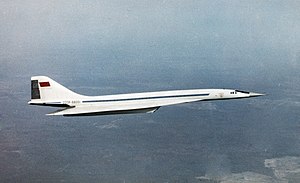Tupolev Tu-144
| Tu-144 | |
|---|---|
 |
|
| Tu-144 prototype in flight on 1 February 1969 | |
| Role | Supersonic airliner |
| National origin | Soviet Union |
| Design group | Tupolev OKB |
| Built by | Voronezh Aircraft Production Association |
| First flight | 31 December 1968 |
| Introduction | 1 November 1977 |
| Status | Retired |
| Primary users |
Aeroflot Ministry of Aviation Industry NASA |
| Produced | 1963–1983 |
| Number built | 16 |
The Tupolev Tu-144 (Russian: Tyполев Ту-144; NATO reporting name: Charger) is a retired jet airliner and commercial supersonic transport aircraft (SST). It is one of only two SSTs to enter commercial service, the other being the Anglo-French Concorde. The design was a product of the Tupolev design bureau, headed by Alexei Tupolev, of the Soviet Union. It conducted 55 passenger service flights, at an average service altitude of 16,000 metres (52,000 ft) and cruised at a speed of around 2,000 kilometres per hour (1,200 mph).
The prototype first flew on 31 December 1968 near Moscow, two months before the first flight of Concorde. The Tu-144 first went supersonic on 5 June 1969, and on 26 May 1970 became the first commercial transport to exceed Mach 2. A Tu-144 crashed in 1973 at the Paris Air Show, delaying its further development. The aircraft was introduced into passenger service on 1 November 1977, almost two years after Concorde, because of budget restrictions. In May 1978, another Tu-144 (an improved version, named Tu-144D) crashed on a test flight while being delivered, and the passenger fleet was permanently grounded after only 55 scheduled flights. The aircraft remained in use as a cargo aircraft until 1983, by which point a total of 102 commercial flights had been completed. The Tu-144 was later used by the Soviet space program to train pilots of the Buran spacecraft, and by NASA for supersonic research.
The Soviet government published the concept of the Tu-144 in an article in the January 1962 issue of the magazine Technology of Air Transport. The air ministry started development of the Tu-144 on 26 July 1963, 10 days after the design was approved by the Council of Ministers. The plan called for five flying prototypes to be built in four years, with the first aircraft to be ready in 1966. The MiG-21I (1968; Izdeliye 21-11; "Analog") I = Imitator ("Simulator") was a testbed for the wing design of the Tu-144.
...
Wikipedia
